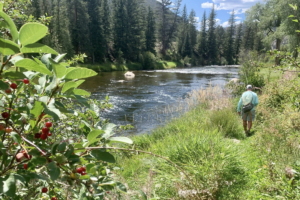Even though fall is still almost a month away, the days are getting noticeably shorter, mornings are feeling colder, and the browns are starting to get their spawning colors. We see a ton of small Midges, consistent Blue Wing Olives, sporadic Flavs/Slate Drakes, and Caddis most afternoons. Taylor Park Reservoir is releasing 230 cfs. We still have fall fishing to look forward to, but the typical late summer doldrums haven’t been as stagnant as usual. Flows through Wilder are still hovering around 280-300 cfs, rain-dependent. The cloudy, rainy weather has kept our water temperature fluctuating between 50 and 60 degrees.
 Mornings on the Taylor River can be challenging. You have a few options; streamer fishing, twitching dries, and nymphing the bottom with small midges. Large Caddis or terrestrials can induce some riveting strikes. The key is covering a lot of water and not being afraid to twitch your fly. Nymphing near the bottom with patterns such as a Pheasant Tail, Zebra Midge, Flash Bang Midge or WD40 should produce eats. Be persistent, and don’t lose hope. Working down into the strike zone is key.
Mornings on the Taylor River can be challenging. You have a few options; streamer fishing, twitching dries, and nymphing the bottom with small midges. Large Caddis or terrestrials can induce some riveting strikes. The key is covering a lot of water and not being afraid to twitch your fly. Nymphing near the bottom with patterns such as a Pheasant Tail, Zebra Midge, Flash Bang Midge or WD40 should produce eats. Be persistent, and don’t lose hope. Working down into the strike zone is key.
 Late mornings and afternoons generally offer some bug activity excitement. Look for small Mayflies first. There have been consistent Blue Wing Olive hatches. Most have been in the size 20-22 range, with a few larger spotted. Occasional PMD/Flav/Slate Drake sightings, especially on cloudy afternoons. Parachute Adams 14-22, Sparkle Dun 14-20, RS2 16-20, Barr’s Emerger 18-20, and Pheasant Tails 14-20 have caught fish. If the fish aren’t eating on the surface, a 12-16 Elk Hair Caddis can be an effective dry, as there will be pockets of egg layers throughout the day. Be on the lookout for an underlying or late afternoon Caddis hatch. Fish have been eager to eat emerging Caddis whenever they are present. X-Caddis 16-18, Elk Hair Caddis 16-18, and BH Caddis Pupa 16-18 should get their attention. Hoppers are still around and available to the fish. Casting hopper patterns into tight places or along grassy banks could pull a surprisingly big fish out of less than 12 inches of water.
Late mornings and afternoons generally offer some bug activity excitement. Look for small Mayflies first. There have been consistent Blue Wing Olive hatches. Most have been in the size 20-22 range, with a few larger spotted. Occasional PMD/Flav/Slate Drake sightings, especially on cloudy afternoons. Parachute Adams 14-22, Sparkle Dun 14-20, RS2 16-20, Barr’s Emerger 18-20, and Pheasant Tails 14-20 have caught fish. If the fish aren’t eating on the surface, a 12-16 Elk Hair Caddis can be an effective dry, as there will be pockets of egg layers throughout the day. Be on the lookout for an underlying or late afternoon Caddis hatch. Fish have been eager to eat emerging Caddis whenever they are present. X-Caddis 16-18, Elk Hair Caddis 16-18, and BH Caddis Pupa 16-18 should get their attention. Hoppers are still around and available to the fish. Casting hopper patterns into tight places or along grassy banks could pull a surprisingly big fish out of less than 12 inches of water.
 The Dream Stream is hard to beat this time of year. Hoppers are everywhere, flying ants are everywhere, Caddis are still around, Trico hatches in the morning, Blue Wing Olive hatches in the afternoon, and the hay meadow will be cut soon too. The terrestrials and Caddis adults don’t become active until the sun warms the valley floor just a little, but once they start flying, they are available to the fish. Size 10-18 Elk Hair
The Dream Stream is hard to beat this time of year. Hoppers are everywhere, flying ants are everywhere, Caddis are still around, Trico hatches in the morning, Blue Wing Olive hatches in the afternoon, and the hay meadow will be cut soon too. The terrestrials and Caddis adults don’t become active until the sun warms the valley floor just a little, but once they start flying, they are available to the fish. Size 10-18 Elk Hair
Caddis, 8-12 Para Hopper, 14-16 Flying Ant, and 8-16 PMX are all good choices. When there is a Trico hatch in the morning, a size 20 Pheasant Tail, 20-22 Para Adams, or 20-22 Tungsten Beatis dropper has produced fish. Look for the spinner fall mid-day. Blue Wing Olives can generally be seen around midday also. They tend to be small still, size 20-22, but there have been enough to bring the fish to the surface.

The ponds are still fishing great with hoppers, Caddis, Midges, and streamers. You will generally see fish cruising for emerging midges in the morning. A 16-20 Sierra Dot, Griffith’s Gnat, Flash Bang Midge or Zebra Midge with a delicate presentation will fool these fish. Twitching hoppers or large Caddis will get some turn downs but will also get some explosions. Stripping streamers or even a single nymph can be a very productive method.
Pinch your barbs,
Ben Riedel
Master Fly Fishing Guide
Wilder on the Taylor









